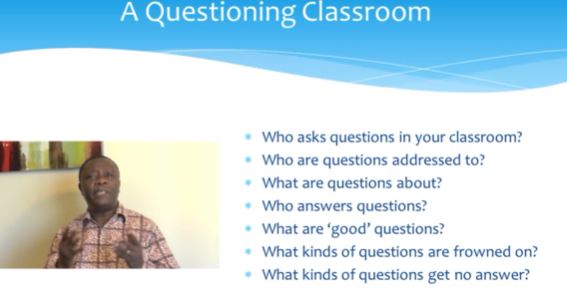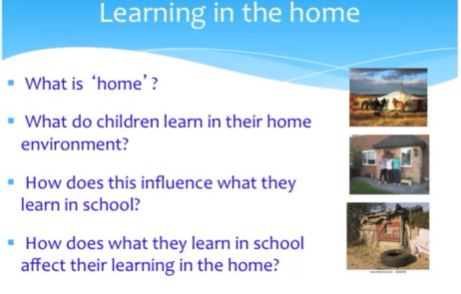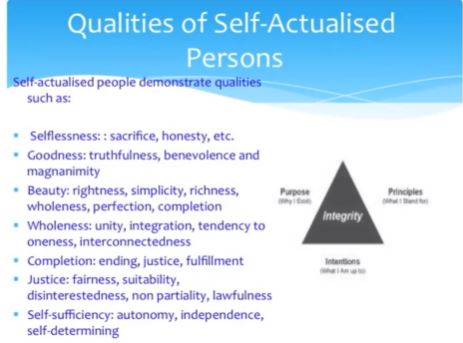#3 Foundations of Teaching for Learning: Learners and Learning
by Commonwealth Education Trust
Dr. George Oduro, and Professor John MacBeath, the director of the program
Week one, we'll focus on who the learners are. Week two, we'll be looking at how learners learn. In week three, we'll be looking at how a teacher can engage with his or her students. Week four, we'll be looking at how the peer and the peer group influences the child's learning. Week five, we'll be trying to explore how learning travels outside the classroom, with specific focus on homework. Then in week six, we'll be exploring some of the thinking that people have about learning. We'll be looking at some key thinkers, such as Muslow, Vikowski, Pyre, Obania, and then Perkins.
Question: How important is it for a teacher to establish and develop their own philosphy of education?
Every teacher has what you might call an implicit theory and those implicit theories work out and, I think, one of our jobs is to help to make those implicit theories or implicit philosophies, more explicit.
Question: What do you think are the main messages to come out of this course, and how do you think the teachers can move forward, in terms of understanding the lives of their children?
> One of the key things I hope students would have is the fact that learning takes place in a friendly environment. Learning takes place when the right things are done at a right time. So, the teachers should ensure that children's voices are heard, so they can use that to plan their learning. They must know their learners, there's a piece that they need to take.
>> I can't argue with that, George. I would say that's pretty much what we're trying to accomplish here and of course, the title of course is learners and learning. And that's a very powerful idea that we need to understand something about those children sitting in front of us in a classroom. They are the learners - but also I think a key point in this is that we are the learners too.
>This reminds of one African writer,, who describes the teacher as a very big schoolboy, who should constantly be learning.
>> Or a very big schoolgirl, for that matter.
Course syllabus
Week One: The lives of children
- Video lecture 1: Who are the learners?
- Video lecture 2: Issues of identity
- Video lecture 3: Boys and girls
- Video lecture 4: The multicultural classroom
Week Two: How children learn
- Video lecture 1: Self confidence and self esteem
- Video lecture 2: The concept of ‘agency’
- Video lecture 3: Differentiating learning and teaching
- Video lecture 4: Rules and roles
Interview One: Looking at weeks one and two
Week Three: Engaging with students
- Video lecture 1: Language in the classroom
- Video lecture 2: Rewarding and celebrating achievement
- Video lecture 3: Questioning in the classroom
- Video lecture 4: Working in pairs, triads and groups
Week Four: The power of the peer group
- Video lecture 1: Understanding peer groups
- Video lecture 2: Smoking, alcohol, drugs and peer pressure
- Video lecture 3: Bullying
- Video lecture 4: Labeling
- Interview Two: Looking at weeks three and four
Week Five: Learning that travels
- Video lecture 1: Learning in the home
- Video lecture 2: Homework
- Video lecture 3: Transitions
- Video lecture 4: The uses and value of indicators
Week Six: Four key thinkers
- Video lecture 1: PaiObanya
- Video lecture 2: David Perkins
- Video lecture 3: Lev Vygotsky
- Video lecture 4: Abraham Maslow
- Interview Three: Looking at weeks five and six
Foundations of Teaching for Learning: Learners and Learning
Week 1 Lecture 1.2: Issues of identity
Video: LectureLecture 1.1: Who are the learners?
Video: LectureLecture 1.2: Issues of identity
Video: LectureLecture 1.3: Boys and girls
Video: LectureLecture 1.4: The multicultural classroom
Question 1
For a teacher to facilitate learning effectively in the classroom, he or she must...
Which of the following is one of the main roles of the teacher?
Have a clear knowledge of who his/her learners are.
Question 2
Which of the following is a challenge for students in engaging with what is being taught?
Dealing with cultural restrictions to learners’ voices
Question 3
Which of the following is a key determinant of the child’s identity?
The relationship culture at home and school
Question 4
Which of the following factors directly help the school in shaping the identity of children?
Children’s participation in creating rules and norms of behaviour
Question 5
Which of the following statements is TRUE about the Caribbean in respects of boys’ and girls’ education?
Question 6
Which of the following is a stereotype held about girls? Girls are:
Collaborative
Question 7
Multiculturalism refers to:
Sharing and celebration of many cultures
Question 8
Which of the following is a way by which the school can promote multiculturalism?
Helping children to develop an attitude of acceptance and respect for other cultures
Question 9
Which of the following describes an anti-racist classroom?
Display anti-racist codes of behavior in the classroom.
Question 10
Which of the following is a goal of a multicultural classroom:
Creating opportunities for children to see that even when people have different customs and traditions, they often share some common traits, too.
Video: LectureLecture 2.1: Self confidence and self esteem
Scott Hamilton has this to say, "Adversity, and perseverance and all these things can shape you.They can give you a value and a self-esteem that is priceless."
Jack Welch also says, "Giving people self-confidence is by far the most important thing that I can do, because then they will act."
Helen Keller says, "Optimism is the faith that leads to achievement. Nothing can be done without hope and confidence."
Lao Tzu says, "Contentment is the greatest treasure.Confidence is the greatest friend."
So, as a teacher, your responsibility is to help children, your learners, develop self-confidence and high self-esteem,because they are paramount in the whole process of learning. So, how do you, as a teacher, help children to move from the negative to the positive in terms of self-confidence and self-esteem? How do you respond to a child who believes: I'm not very clever; I can't do it; Nobody likes me; People make fun of me;
Video: LectureLecture 2.2: The concept of 'agency'
Teacher agent ---> students' agency
Agency has been defined as the capacity of an agent, a human being or any living being, to act in the world to make a choice, to think independently and to assume responsibility for their actions.It may be a conscious thought through choice, or unconscious.
Video: LectureLecture 2.3: Differentiating learning and teaching
Video: LectureLecture 2.4: Rules and roles
Question 1
The notion of self esteem is important for teachers because...
There is a strong relationship between children’s self esteem and their engagement with
Question 2
Locus of control refers to...
The need for students to believe that they have the power to act and to make decisions
Question 3
Which of the following is the most acceptable statement in relation to the nature of moral choice?
Moral choices are made by children with the help of teachers and parents
Question 4
Agency refers to:
The capacity of a pupil or teacher to make a choice, to think independently and to assume responsibility for his or her actions
Question 5
The notion of teachers ‘letting go’ refers to...
The opportunity for teachers to take more risks and allow enhanced responsibilities to their students
Question 6
Differentiation in the classroom refers to...
The process by which objectives, teaching methods, assessment, resources and learning activities are planned to cater for the needs of individual pupils
Question 7
Differentiation takes different forms one of which is described as differentiation by support. This refers to:
The support that is offered by the teacher to students on the basis of perceived needs
Question 8
Who should decide on classroom rules...
Is an important question because who makes the rules and how they are made influences the extent to which they will be observed by young people
Question 9
Clarifying roles in the classroom help to diminish the emphasis on rules by...
Creating an ethos in which there is heightened sense of responsibility and personal authority among students
Question 10
Optimism...
means having faith that children will constantly surprise you by their insights and creativity
Video: LectureLecture 3.1: Language in the classroom
"Contents of human's semantic representation and the meanings we attach to a phenomenon are tied up with our everyday use of language." -Frawley 1992
"Linguistic meaning is entirely determined by the cultural context in which language occurs."- Forrester, 1996
"The limits of my world are the limits of my language." -Wittgenstein,1953
Video: LectureLecture 3.2: Rewarding and celebrating achievement
Video: LectureLecture 3.3: Questioning in the classroom
Video: LectureLecture 3.4: Working in pairs, triads, and groups
Video: LectureLecture 4.1: Understanding peer groups
Video: LectureLecture 4.2: Smoking, alcohol, drugs and peer pressure
Video: LectureLecture 4.3: Bullying
Video: LectureLecture 4.4: Labeling
Video: Lecture 6.1: PaiObanya
principle one of Pai Obanya's philosophy is that there should be a re-conceptualisation of the teacher's role.That the teacher should be seen more as a facilitator in the classroom. and he's very emphatic that the teacher should move away from lecturing-
the child gets to the classroom with an attitude of, "I'm here to be taught".That must change to "I'm here to learn, to engage in the learning processes."
let me just give you an example, that even at a university level there are some students who find teachers who engage students in discovering things for themselves as not being good teachers. So, they prefer teachers who will come and give out lecture notes for them to copy.
Video: Lecture 6.2: David Perkins (He is very practical)
It's all about how do you connect the learning and teaching.
Because, first of all, he talks about how you have to deconstruct the game. Now, go back to the metaphor of the jigsaw puzzle, where you've got all the little bits and how they fit together. So, in order to make the jigsaw puzzle kind of work, or fit the pieces together, you have to understand how the pieces all fit. So, in a way, you have to come back and deconstruct, take out the individual pieces, so that you can understand better how they learn, and how they fit together.teachers don't always share with young people some of the deeper structures, or some of the other kinds of things that are involved in learning. So, if we were talking about learning how to learn, you would be then helping young people to understand what's often hidden, which is the how to learn, rather than just the content of learning.
I think the notion is as illustrated in this teddy bear, the child teaching the teddy bear. He's now the smartest teddy bear on my street or in my house because this little girl comes home from school, talks to the teddy bear about her learning and because she's rehearsing it and she's talking out loud, she is actually internalising her thinking.
Video: Lecture 6.4: Abraham Maslow
notion of service or servant leadership for other people
Question 1
One of David Perkins’ principles is to ‘play the whole game’. This is a reference to:
The need to know from the start the goal and what the whole ‘game’ will entail
Question 2
Perkins’ reference to ‘deconstructing the game’ means...
Singling out all the hard parts and giving them special attention
Question 3
Perkins’ concept of ‘playing out of town’ refers to:
To meet the challenge of ‘playing’ in an unfamiliar environment, rather than the home pitch
Question 4
The ‘hidden game’ is a reference to:
The deep structures of a discipline or learning task which are not always obvious to the learner
Question 5
A ‘social constructivist perspective’ holds that:
Learning is a process of ‘constructing' thinking from what children observe and experience from the social world around them
Question 6
Vygotsky’s concept of ‘scaffolding’ is useful for teachers because...
It provides a framework of support when new concepts or skills are being introduced
Question 7
Maslow’s hierarchy of needs, revisited in this course, makes an important contribution to learning and teaching because...
Reminds us that it is fairly futile to try to meet higher order needs when lower order needs have not been met
Question 9
Pai Obanya believes that
Politics has a direct influence on education
Question 10
Transformational pedagogy, says Pai Obanya, ...
Requires a complete re-conceptualization of the roles and functions of the teacher




















































































No comments:
Post a Comment